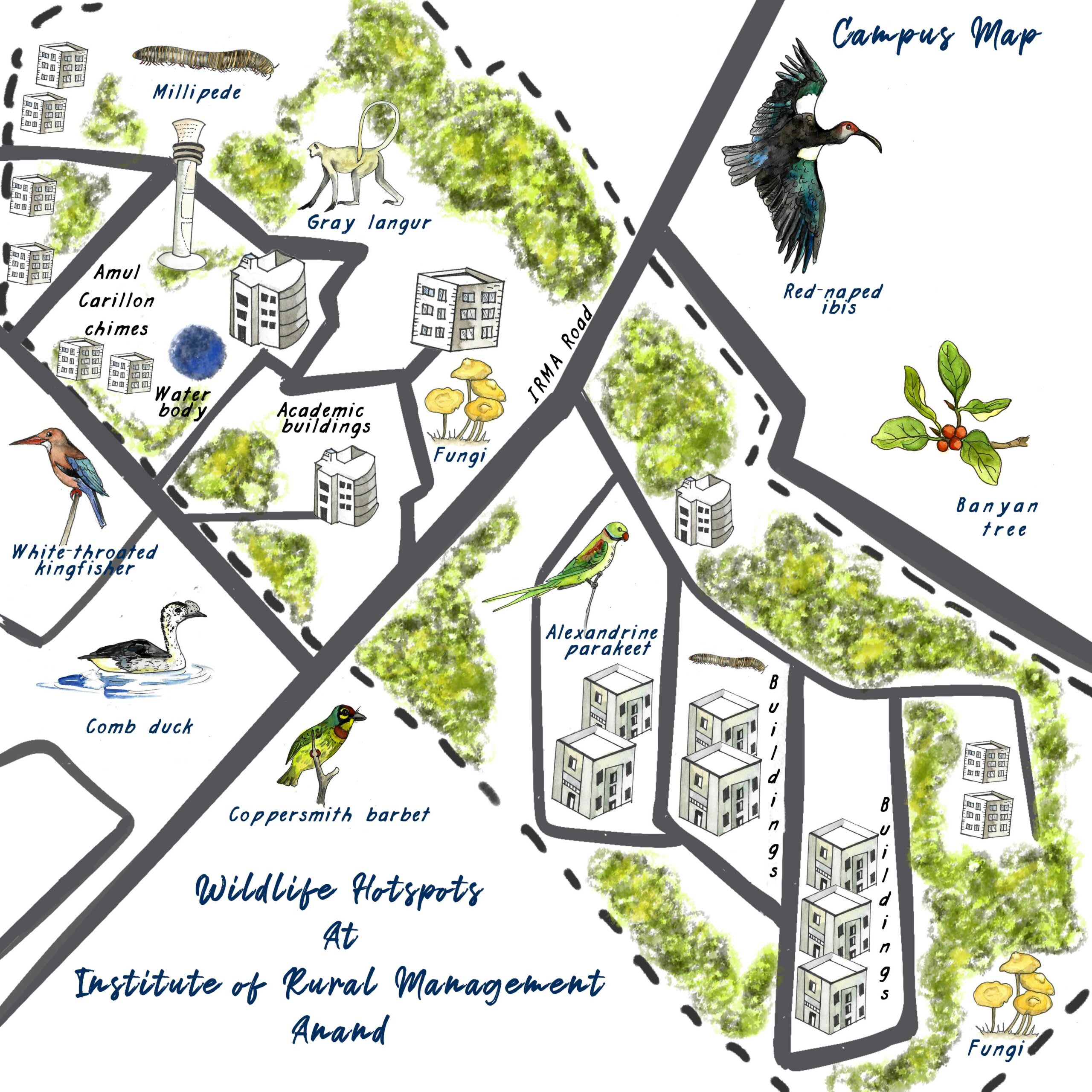The first morning after I moved into the campus of the Institute of Rural Management in Gujarat, I felt disoriented. For one, I had not expected to hear the unrelenting excited shrieks of hundreds of parakeets. I had just completed a few harrowing months defending my doctoral thesis, with anxiety compounded in the wake of the pandemic. Amid mounting uncertainties, a job offer that included the phrase “residential facilities in a 60-acre campus” had me packing my belongings the very next day. I desperately needed a change of air, even if it meant moving cities in the middle of the pandemic in July 2020.


Representational map of the campus (not to scale). The brutalist architecture (minimalist 1950s style) of the buildings with rough exteriors offers ideal perches for many birds. Cover: Black-rumped flamebacks are one of the few woodpeckers found in urban areas. They mainly feed on insects from under the tree bark but adapt well in human-modified habitats to feed on fruits and food waste as well.
The IRMA campus, established in 1979, lies adjacent to the sprawling farmlands of Anand Agricultural University. The roads are lined with gulmohar, copper pod, laburnum and jacaranda trees. But it was a giant banyan tree that I almost instantly fell in love with, its aerial roots beckoning all forms of life to rest under the shade. Numerous langurs groomed each other while the younger ones jostled playfully, trapezing amongst the canopies with a carefree elegance. I could only indulge in the vicarious thrill of such acrobatics, as my limbs felt decidedly useless in their company. Instead, I would follow them around when I could, wanting, like a new neighbour, to familiarise myself with the trees and their residents.
What better way to know a place other than walk through it? As Rebecca Solnit beautifully describes in her book Wanderlust: A history of walking, “Walking shares with making and working that crucial element of engagement of the body and the mind with the world, of knowing the world through the body and the body through the world.” I felt the anxious chitter inside my mind quieten as a flock of raucous jungle babblers took centre stage instead. I let auditory trails guide me instead of solely relying on vision, revelling in the small discoveries accompanying such sensory attention. A “tck tck tck” sound led to observing the skills of the black-rumped flameback woodpecker, as it expertly gathered grubs from notches in the tree trunks, only to be shooed away by rose-ringed parakeets nesting in the hollowed wood. I was thrilled to observe a family of spotted-owlets and made it a morning ritual to see them snuggle on their beloved branch. When the Tauktae cyclone hit Gujarat in 2021, many trees were uprooted and damaged in the aftermath. As soon as the rains abated, I stepped out to see the extent of the damage and felt a wave of relief pass through me when I saw the owlets sitting on the same miraculously intact branch.
Anthropologist Tim Ingold argues that education should be understood as the honing of one’s attention, because it is only through attentive dwelling within our surroundings can we find the capacity to care and act. A tree then ceases to be an object, and instead embeds itself in a web of relations of which we are a part. I became familiar with the wooded patches favoured by peacocks trying to woo the peahens, who sharply observe every move made by the prospective suitors. Red-naped ibis, as plentiful and common as chickens in a backyard, expertly scan the subterranean buffet, their long beaks rarely emerging without a grub. Their loud and raucous mating calls were another matter altogether though, and probably add to some bizarre symphony in the avian world.
Even after two years of walking through every inch of this campus, I realise familiarity only unveils newer dimensions of novelty. A frangipani tree seems to attract many sunbirds, while the berries of a particular fish palm tree are sought after by the Alexandrine parakeets. A small lily pond is the perfect spot to greet the white-throated kingfishers and visiting knob-billed ducks. I involuntarily cock my ears in the direction of the rhythmic calls of a coppersmith barbet and eventually spot it chipping away at a tree trunk to make a hollow nest.
Personalities and eccentricities emerge. The richness of individual lives unfolds amidst canopies and branches. In her brilliant book titled The Bird Way, Jennifer Ackerman comments on how birds continually lead us to revise our assumptions of human uniqueness through their sophisticated behaviours involving tool-making, subterfuge, creativity, playfulness, and adaptability. Learning to recognise these interactions, even in small measures, enriches my sense of dwelling in the place.
The ground is no less intriguing and complex, even though it might be less accessible to our impoverished senses. Many varieties of fungi take over decaying logs of wood and the bases of tree trunks, while an exodus of thousands of millipedes could only leave one guessing at the flurry of activity underneath. A new field called soil bioacoustics allows researchers to listen to the throes of activity underground, allowing them to add newer perspectives to the phrase “alive and kicking”.
The term rewilding is used to describe the restoration of ecosystems by introducing species and rebuilding habitats. I wonder if the same doesn’t apply to us? How about rewilding ourselves to be more attuned to the connections sustaining our lives? Biologist EO Wilson argued that we are genetically predisposed to feel affection towards other living beings and natural surroundings since our lives depended on an intimate knowledge of the environment and termed the phenomenon Biophilia. Now, like an amnesic, we can’t quite figure out why the fragrance of moist Earth uplifts our senses or why the rustling of leaves on a windy day calms the mind. Yet, the body beckons us to remember. Shouldn’t we allow it to lead the way?

